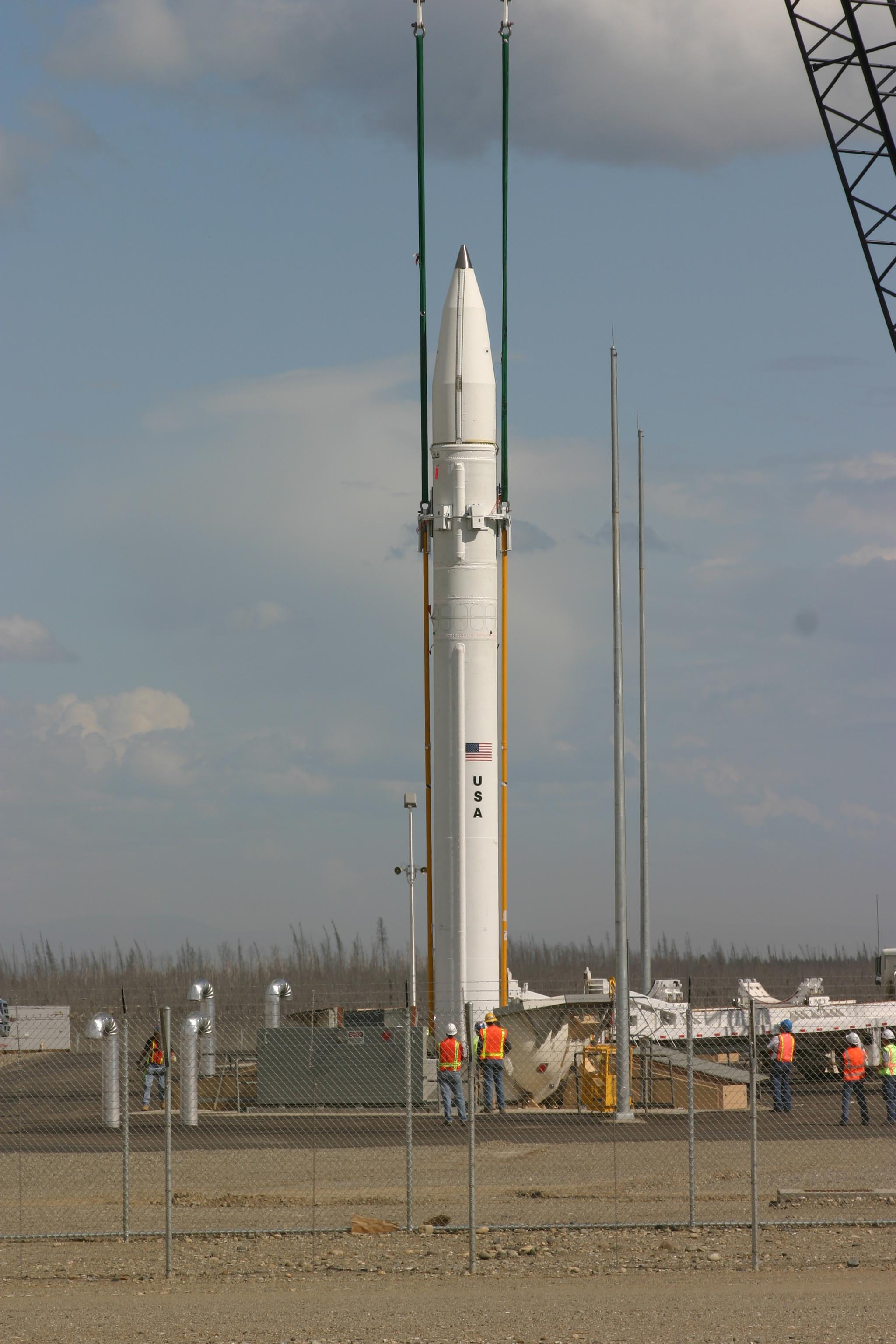|
Dongfeng 5
The Dongfeng 5 () or DF-5 is a second-generation two stage Chinese intercontinental ballistic missile. It has a length of 32.6 m and a diameter of 3.35 m. It weighs in at 183,000 kilograms and it has an estimated range of 12,000 to 15,000 kilometers. The DF-5 had its first flight in 1971 and was in operational service 10 years later. One of the limitations of the missile is that it takes between 30 and 60 minutes to fuel. The DF-5 is due to be replaced by the solid-fuelled DF-41. Around 2015, the newest variant DF-5B force are believed to have received a MIRV upgrade; according to ''Business Insider'', with DF-5B: "China has the ability to deliver nuclear warheads nearly anywhere on earth (outside of South America, at least)". History The DF-5 was designed under the leadership of Tu Shou'e ± å®é· at the China Academy of Launch Technology (CALT); Li Xu'e 绪éserved as deputy chief designer. The missile was produced at the China's Factory 211 (Capital Astronautics Co. ¦ ... [...More Info...] [...Related Items...] OR: [Wikipedia] [Google] [Baidu] |
ICBM
An intercontinental ballistic missile (ICBM) is a ballistic missile with a range greater than , primarily designed for nuclear weapons delivery (delivering one or more thermonuclear warheads). Conventional, chemical, and biological weapons can also be delivered with varying effectiveness, but have never been deployed on ICBMs. Most modern designs support multiple independently targetable reentry vehicles (MIRVs), allowing a single missile to carry several warheads, each of which can strike a different target. Russia, the United States, China, France, India, the United Kingdom, and North Korea are the only countries known to have operational ICBMs. Early ICBMs had limited precision, which made them suitable for use only against the largest targets, such as cities. They were seen as a "safe" basing option, one that would keep the deterrent force close to home where it would be difficult to attack. Attacks against military targets (especially hardened ones) still demanded th ... [...More Info...] [...Related Items...] OR: [Wikipedia] [Google] [Baidu] |
Throw-weight
A ballistic missile is a type of missile that uses projectile motion to deliver warheads on a target. These weapons are guided only during relatively brief periodsâmost of the flight is unpowered. Short-range ballistic missiles stay within the Earth's atmosphere, while intercontinental ballistic missiles (ICBMs) are launched on a sub-orbital flight. These weapons are in a distinct category from cruise missiles, which are aerodynamically guided in powered flight. Unlike cruise missiles, which are restricted to the atmosphere, it is advantageous for ballistic missiles to avoid the denser parts of the atmosphere and they may travel above the atmosphere into outer space. History The earliest form of ballistic missile dates from the 13th century with its use derived from the history of rockets. In the 14th century, the Ming Chinese navy used an early form of a ballistic missile weapon called the Huolongchushui in naval battles against enemy ships.Needham, Volume 5, Part 7, ... [...More Info...] [...Related Items...] OR: [Wikipedia] [Google] [Baidu] |
DF-21
The Dong-Feng 21 (DF-21; NATO reporting name CSS-5 - Dong-Feng () is a two-stage, solid-fuel rocket, single-warhead medium-range ballistic missile (MRBM) in the Dong Feng series developed by China Changfeng Mechanics and Electronics Technology Academy. Development started in the late 1960s and was completed around 1985â86, but it was not deployed until 1991. It was developed from the submarine-launched JL-1 missile, and is China's first solid-fuel land-based missile. The U.S. Department of Defense in 2008 estimated that China had 60-80 missiles and 60 launchers; approximately 10-11 missiles can be built annually. Originally developed as a strategic weapon, the DF-21's later variants were designed for both nuclear and conventional missions. It is thought able to carry a high explosive, submunition, or 300 kt nuclear warhead. The latest DF-21D was said to be the world's first anti-ship ballistic missile (ASBM). The DF-21 has also been developed into a space-capable anti-sate ... [...More Info...] [...Related Items...] OR: [Wikipedia] [Google] [Baidu] |
LGM-25C Titan II
The Titan II was an intercontinental ballistic missile (ICBM) developed by the Glenn L. Martin Company from the earlier Titan I missile. Titan II was originally designed and used as an ICBM, but was later adapted as a medium-lift space launch vehicle (these adaptations were designated Titan II GLV and Titan 23G) to carry payloads to Earth orbit for the United States Air Force (USAF), National Aeronautics and Space Administration (NASA) and National Oceanic and Atmospheric Administration (NOAA). Those payloads included the USAF Defense Meteorological Satellite Program (DMSP), NOAA weather satellites, and NASA's Gemini crewed space capsules. The modified Titan II SLVs (Space Launch Vehicles) were launched from Vandenberg Air Force Base, California, up until 2003. Titan II missile The Titan II ICBM was the successor to the Titan I, with double the payload. Unlike the Titan I, it used hydrazine-based hypergolic propellant which was storable and reliably ignited. This red ... [...More Info...] [...Related Items...] OR: [Wikipedia] [Google] [Baidu] |
R-36 (missile)
The R-36 (russian: Ð -36) is a family of intercontinental ballistic missiles (ICBMs) and space launch vehicles (Tsyklon) designed by the Soviet Union during the Cold War. The original R-36 was deployed under the GRAU index 8K67 and was given the NATO reporting name SS-9 Scarp. It was able to carry three warheads and was the first Soviet MRV (multiple re-entry vehicle) missile. The later version, the R-36M was produced under the GRAU designations 15A14 and 15A18 and was given the NATO reporting name SS-18 Satan. This missile was viewed by certain United States analysts as giving the Soviet Union first strike advantage over the U.S., particularly because of its rapid silo-reload ability, very heavy throw weight and extremely large number of re-entry vehicles. Some versions of the R-36M were deployed with 10 warheads and up to 40 penetration aids and the missile's high throw-weight made it theoretically capable of carrying more warheads or penetration aids. Contemporary U.S. miss ... [...More Info...] [...Related Items...] OR: [Wikipedia] [Google] [Baidu] |
The Washington Free Beacon
''The Washington Free Beacon'' is an American conservative political journalism website launched in 2012. The website is financially backed by Paul Singer, an American billionaire hedge fund manager and conservative activist. History The ''Free Beacon'' was founded by Michael Goldfarb, Aaron Harrison, and Matthew Continetti. It launched on February 7, 2012, as a project of the Center for American Freedom, a conservative advocacy group modeled on the liberal Center for American Progress. The site is known for its conservative reporting, with the intention of publicizing stories and influencing the coverage of the mainstream media, and modeled after liberal counterparts in the media such as ''Think Progress'' and ''Talking Points Memo''. The site has roots in the neoconservative wing of the Republican Party. Jack Hunter, a staff member of Senator Rand Paul's office, resigned in 2013 after a ''Free Beacon'' report detailing his past as a pro-secessionist radio shock jock ... [...More Info...] [...Related Items...] OR: [Wikipedia] [Google] [Baidu] |
Ground-Based Midcourse Defense
Ground-Based Midcourse Defense (GMD) is the United States' anti-ballistic missile system for intercepting incoming warheads in space, during the midcourse phase of ballistic trajectory flight. It is a major component of the American missile defense strategy to counter ballistic missiles, including intercontinental ballistic missiles (ICBMs) carrying nuclear, chemical, biological or conventional warheads. The system is deployed in military bases in the states of Alaska and California; in 2018 comprising 44 interceptors and spanning 15 time zones with sensors on land, at sea, and in orbit. In 2019, a missile defense review requested that 20 additional ground-based interceptors be based in Alaska. GMD is administered by the U.S. Missile Defense Agency (MDA), while the operational control and execution is provided by the U.S. Army, and support functions are provided by the U.S. Air Force. Previously known as National Missile Defense (NMD), the name was changed in 2002 to different ... [...More Info...] [...Related Items...] OR: [Wikipedia] [Google] [Baidu] |
The Diplomat
''The Diplomat'' is an international online news magazine covering politics, society, and culture in the Indo-Pacific region. It is based in Washington, D.C. It was originally an Australian bi-monthly print magazine, founded by Minh Bui Jones, David Llewellyn-Smith and Sung Lee in 2001, but due to financial reasons it was converted into an online magazine in 2009 and moved to Japan and later Washington, D.C. The magazine is currently owned by MHT Corporation. History ''The Diplomat'' was originally an Australian bi-monthly print magazine, founded by Minh Bui Jones, David Llewellyn-Smith and Sung Lee in 2001. The first edition was published in April 2002, with Bui Jones as the founding editor and Llewellyn-Smith the founding publisher. The magazine was acquired by James Pach through his company Trans-Asia Inc. in December 2007. Pach assumed the role of executive publisher and hired former ''Penthouse'' editor Ian Gerrard to update its presentation. Nonetheless, the print ed ... [...More Info...] [...Related Items...] OR: [Wikipedia] [Google] [Baidu] |
Jane's Defence Weekly
''Jane's Defence Weekly'' (abbreviated as ''JDW'') is a weekly magazine reporting on military and corporate affairs, edited by Peter Felstead. It is one of a number of military-related publications named after John F. T. Jane, an Englishman who first published '' Jane's All the World's Fighting Ships'' in 1898. It is a unit of Jane's Information Group, which was purchased by IHS in 2007. The magazine has a large circulation and is frequently cited in publications worldwide. History ''Jane's Defence Weekly'' was established in 1984 replacing the now-defunct ''Jane's Defence Review''. The latter was started in 1978 and was published on a monthly basis. Samuel Loring Morison In 1984, only months after the magazine was established, ''Jane's Defence Weekly'' gained worldwide attention after printing several images from an American spy satellite of the Nikolaiev 444 shipyard in the Black Sea, showing a Kiev-class aircraft carrier under construction.https://news.google.com/newspapers? ... [...More Info...] [...Related Items...] OR: [Wikipedia] [Google] [Baidu] |
Missile
In military terminology, a missile is a guided airborne ranged weapon capable of self-propelled flight usually by a jet engine or rocket motor. Missiles are thus also called guided missiles or guided rockets (when a previously unguided rocket is made guided). Missiles have five system components: targeting, guidance system, flight system, engine and warhead. Missiles come in types adapted for different purposes: surface-to-surface and air-to-surface missiles (ballistic, cruise, anti-ship, anti-submarine, anti-tank, etc.), surface-to-air missiles (and anti-ballistic), air-to-air missiles, and anti-satellite weapons. Airborne explosive devices without propulsion are referred to as shells if fired by an artillery piece and bombs if dropped by an aircraft. Unguided jet- or rocket-propelled weapons are usually described as rocket artillery. Historically, the word ''missile'' referred to any projectile that is thrown, shot or propelled towards a target; this usage is still ... [...More Info...] [...Related Items...] OR: [Wikipedia] [Google] [Baidu] |
National Air And Space Intelligence Center
The National Air and Space Intelligence Center (NASIC) is the United States Air Force unit for analyzing military intelligence on foreign air and space forces, weapons, and systems. NASIC assessments of aerospace performance characteristics, capabilities, and vulnerabilities are used to shape national security and defense policies and supports weapons treaty negotiations and verification. History In 1917 the Foreign Data Section of the Army Signal Corpsâ Airplane Engineering Department was established at McCook Field, and a NASIC predecessor operated the Army Aeronautical Museum of the Material Division, August 22, 1935. The Office of the Chief of Air Corps's Information Division had become the OCAC Intelligence Division by 1939, which transferred into the United States Army Air Forces (USAAF) as AC/AS, Intelligence and was known as A-2 (in April, 1942, the Air Intelligence School was at the Harrisburg Academy.) The United States Army Air Forces evaluated foreign aircraft ... [...More Info...] [...Related Items...] OR: [Wikipedia] [Google] [Baidu] |
Missile Silo
A missile launch facility, also known as an underground missile silo, launch facility (LF), or nuclear silo, is a vertical cylindrical structure constructed underground, for the storage and launching of intercontinental ballistic missiles (ICBMs), intermediate-range ballistic missiles (IRBMs), medium-range ballistic missiles (MRBMs). Similar facilities can be used for anti-ballistic missiles (ABMs). The structures typically have the missile some distance below ground, protected by a large "blast shelter, blast door" on top. They are usually connected, physically and/or electronically, to a missile launch control center. With the introduction of the Soviet UR-100 and the U.S. LGM-25C Titan II, Titan II missile series, underground silos changed in the 1960s. Both missile series introduced the use of hypergolic propellant, which could be stored in the missiles, allowing for rapid launches. Both countries' liquid-fueled missile systems were moved into underground silos. The introduc ... [...More Info...] [...Related Items...] OR: [Wikipedia] [Google] [Baidu] |




